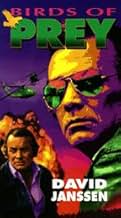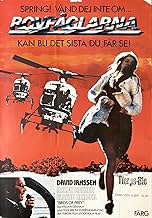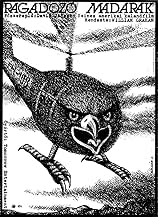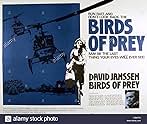IMDb RATING
6.6/10
453
YOUR RATING
A former fighter pilot now working as a radio station traffic reporter witnesses a bank robbery. He chases down the bank robbers and a hostage in his helicopter.A former fighter pilot now working as a radio station traffic reporter witnesses a bank robbery. He chases down the bank robbers and a hostage in his helicopter.A former fighter pilot now working as a radio station traffic reporter witnesses a bank robbery. He chases down the bank robbers and a hostage in his helicopter.
James W. Gavin
- Police Pilot
- (as Gavin James)
Wayne D. Wilkinson
- Alouette Crew Member
- (as Wayne Wilkinson)
Larry Peacy
- Alouette Crew Member
- (as Larry Peacey)
Featured reviews
I saw this TV movie when it first appeared on television. I was riveted. The flying scenes were superb, and it was fast moving. One of David Jansen's best performances. The main character seemed to come alive, and you were able to see what events in his past shaped who he was. Just wish it were available on video.
David Jansen plays the phenominal role of ex-World War II fighter pilot who is a traffic heliocopter pilot. After seeing robbers flee a crime in a heliocopter he follows, refuels along the road, frees the hostage and enters into a showdown with the robbers.
The film has many scenes of sensational flying.
The film has many scenes of sensational flying.
10Ralpho
David Janssen and Ralph Meeker are perfectly cast in this TV movie as World War II flying buddies who have had disparate levels of success in adjusting to post-war life. Meeker's character, McAndrews, is an apparently well-balanced police captain in Salt Lake City. Janssen's character, Harry Walker, flies a helicopter for a local radio station and has not been able to put the war behind him.
Janssen's character witnesses a bank robbery and chases the perpetrators, who are also in a helicopter. The aerial stunt work is top-notch, and the film was made on location in Salt Lake City at a time when you could fake very little with special effects.
But the core of the movie is the relationship between Walker and McAndrews. Walker feels alive for the first time in a long time as he chases the bad guys. McAndrews tries to restrain Walker through most of the movie, although it's clear he sympathizes with his old friend. And at the end he's as crazy as Walker.
When the movie was originally televised, a beautiful and perfectly appropriate version of the song "I'll Get By" played over the opening credits. I have searched long and hard for a recording of that version of that song without success. It wasn't the cover by Keely Smith, or by Billie Holliday.
I wouldn't have looked so hard for a recording if the song was included in the videotape of "Birds of Prey." I suspect that whoever put the movie on video would have had to pay royalties to someone if the song was retained. So this despicable person replaced "I'll Get By" with an instrumental big band song that is probably in the public domain.
This thrifty gent likewise axed a song from the body of the movie to which Janssen's character sings along. So the videotape viewer is left to wonder what song Janssen is singing as an instrumental big band number plays.
Janssen's character witnesses a bank robbery and chases the perpetrators, who are also in a helicopter. The aerial stunt work is top-notch, and the film was made on location in Salt Lake City at a time when you could fake very little with special effects.
But the core of the movie is the relationship between Walker and McAndrews. Walker feels alive for the first time in a long time as he chases the bad guys. McAndrews tries to restrain Walker through most of the movie, although it's clear he sympathizes with his old friend. And at the end he's as crazy as Walker.
When the movie was originally televised, a beautiful and perfectly appropriate version of the song "I'll Get By" played over the opening credits. I have searched long and hard for a recording of that version of that song without success. It wasn't the cover by Keely Smith, or by Billie Holliday.
I wouldn't have looked so hard for a recording if the song was included in the videotape of "Birds of Prey." I suspect that whoever put the movie on video would have had to pay royalties to someone if the song was retained. So this despicable person replaced "I'll Get By" with an instrumental big band song that is probably in the public domain.
This thrifty gent likewise axed a song from the body of the movie to which Janssen's character sings along. So the videotape viewer is left to wonder what song Janssen is singing as an instrumental big band number plays.
This film was part of the edge-of-your-seat action/chase genre made popular in the '70s. Films like Vanishing Point, and Smokey and the Bandit, where nothing more than a car chase sequence with a little cohesive drama or comedy thrown in.
The makers of Birds of Prey obviously had the same thing in mind, but they added an interesting twist; helicopters instead of cars.
David Janssen plays Harry Walker, an ex-WWII fighter pilot longing for the glory days of dog fights and heroic aerobatics. He is a now twice divorced, lonely, and somewhat bitter, Salt Lake City helicopter traffic reporter. Ralph Meeker plays Jim "Mac" McAndrew, a former war buddy of Walker's who prefers to stay on the ground, forget flying, war planes, and the past, to focus on the his career as a Salt Lake City cop.
On a routine day Walker witnesses a bank robbery from the air. He calls it into Mac who thinks he's pulling a gag. The robbers kill a bank guard and take a hostage then get away in a stolen car. The chase begins. The police join the chase as car and chopper scream through urban Salt Lake City.
This was a pretty good film for a made-for-TV movie. The flying sequences are well done and well coordinated. The flying stunts, including diving under overpasses, flying into and out of buildings, tumbling (auto-rotating), and flying between sky scrapers, are all done with real helicopters. No toys on strings or models with goofy trick photography were used. The acting and drama aren't bad, but that's not what this movie's about. Like Top Gun, this movie's about flying.
The makers of Birds of Prey obviously had the same thing in mind, but they added an interesting twist; helicopters instead of cars.
David Janssen plays Harry Walker, an ex-WWII fighter pilot longing for the glory days of dog fights and heroic aerobatics. He is a now twice divorced, lonely, and somewhat bitter, Salt Lake City helicopter traffic reporter. Ralph Meeker plays Jim "Mac" McAndrew, a former war buddy of Walker's who prefers to stay on the ground, forget flying, war planes, and the past, to focus on the his career as a Salt Lake City cop.
On a routine day Walker witnesses a bank robbery from the air. He calls it into Mac who thinks he's pulling a gag. The robbers kill a bank guard and take a hostage then get away in a stolen car. The chase begins. The police join the chase as car and chopper scream through urban Salt Lake City.
This was a pretty good film for a made-for-TV movie. The flying sequences are well done and well coordinated. The flying stunts, including diving under overpasses, flying into and out of buildings, tumbling (auto-rotating), and flying between sky scrapers, are all done with real helicopters. No toys on strings or models with goofy trick photography were used. The acting and drama aren't bad, but that's not what this movie's about. Like Top Gun, this movie's about flying.
I've seen "Birds of Prey" only once, decades ago, but I remember it as great fun. It's also a piece of cultural history. It first aired on TV in January 1973, as the U.S. war in Vietnam was officially rushing to an end, and it's a cops-and-robbers adventure about helicopters, the chariots of choice of that conflict.
The setting is a big city in the American West. The villains are robbers -- Vietnam vets, perhaps? -- who make their getaway by chopper. The squabbling heroes are two middle-aged men who served together in World War II. One of them (played by Ralph Meeker) is now a successful bureaucrat, serving as the city's police chief. The other (played by David Janssen) is somewhere between a free spirit and a ne'er-do-well, a man who flies a traffic helicopter to earn a living but has never left behind the memories of the air war of his youth. When the robbers take to the skies, the battle of the generations is on.
They didn't call such men such as Meeker's and Janssen's characters "the greatest generation" in 1973. They called them "the establishment." This movie is nostalgia for the simplicities of World War II before such nostalgia was fashionable.
If the DVD version does indeed feature modern rock instead of the original movie's 1940s sound track, it's a shame. But maybe it's inevitable. Now that the World War II veterans have grown old and the Vietnam veterans have taken their place in the middle-aged zone, few viewers would recognize the great big band standards. Alas, time flies. Like a bird.
The setting is a big city in the American West. The villains are robbers -- Vietnam vets, perhaps? -- who make their getaway by chopper. The squabbling heroes are two middle-aged men who served together in World War II. One of them (played by Ralph Meeker) is now a successful bureaucrat, serving as the city's police chief. The other (played by David Janssen) is somewhere between a free spirit and a ne'er-do-well, a man who flies a traffic helicopter to earn a living but has never left behind the memories of the air war of his youth. When the robbers take to the skies, the battle of the generations is on.
They didn't call such men such as Meeker's and Janssen's characters "the greatest generation" in 1973. They called them "the establishment." This movie is nostalgia for the simplicities of World War II before such nostalgia was fashionable.
If the DVD version does indeed feature modern rock instead of the original movie's 1940s sound track, it's a shame. But maybe it's inevitable. Now that the World War II veterans have grown old and the Vietnam veterans have taken their place in the middle-aged zone, few viewers would recognize the great big band standards. Alas, time flies. Like a bird.
Did you know
- TriviaThe Hughes 500C that "Walker" flew throughout the film is one of the few turbine-engine helicopters (worldwide) which is flown single-pilot from the left seat. Since people tend to scan visually from left to right... the same way they read a book... it was more effective to have Walker in a left-facing helicopter like the 500C, as opposed to say, a Bell JetRanger, or a Fairchild FH-1100 which are flown from the right seat. Director William A. Graham shot all of the close-ups from the left side of the ship, usually looking slightly upward, with a tight depth-of-field. This threw everything behind Walker's shoulders out of focus. However, this was a dual-control ship! Note particularly the take-off after Walker fueled-up from the tanker truck. If you look closely (despite the fuzzy focus) you can readily see that the right-seat position looks unusually lumpy. That's because the film pilot who was doing the actual flying, was crouched in there, under a black shroud.
- GoofsThe Hughes/MD 500 (369) helicopter has a jet turbine engine that uses Jet-A fuel. Filling up with auto gas from the tanker truck would not work well. The engine would be damaged and would not get very far.
- Quotes
Jim McAndrew: Hey Walker, remember how we used to make simultaneous approaches on intersecting runways?
- ConnectionsReferenced in Vivre à trois: Two Flew Over the Cuckoo's Nest (1981)
Details
Box office
- Budget
- $400,000 (estimated)
Contribute to this page
Suggest an edit or add missing content

























